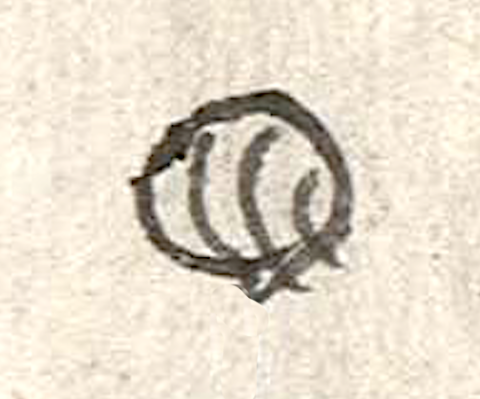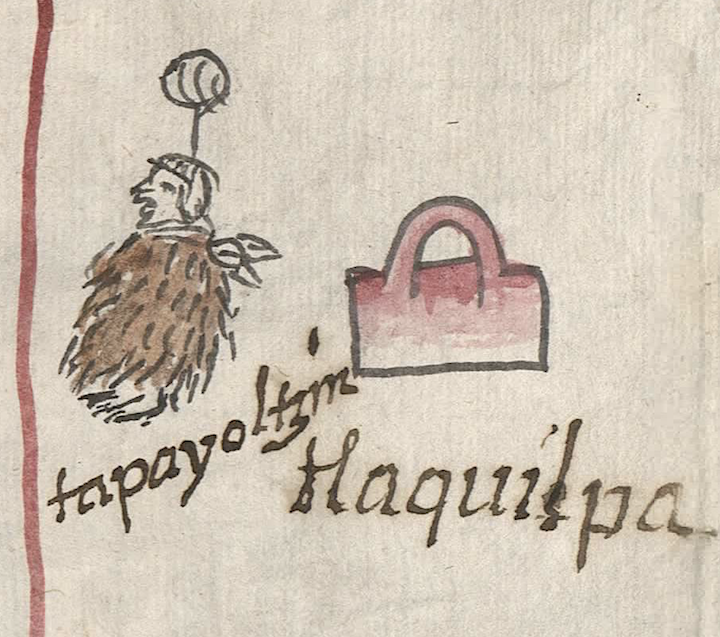Tapayoltzin (CmpRG)
This is a simplex glyph stands for Tapayoltzin, the name of a man who appears on the 1580 Relación Geográfica de Cempoala (Cempohuallan, today Zempoala, Hidalgo) in association with the cabecera (head town) of Tlaquilpan. The simplex glyph is connected to the crown of this figure’s head by a black line. The ball (tapayolli) is marked with three curved black lines in its interior suggesting some kind of texture. The ball is not colored. The -tzintli ending, in this case serving as an honorific attached to the personal name, is not visualized but only shown in the alphabetic gloss.
Robert Haskett
It is not clear exactly what kind of ball is depicted by this simplex glyph. It is similar to the name glyph of a man found in the Matrícula de Huexotzinco. It is unlike the solid black balls associated with rubber (olli) (see below). There is a verb, tapayoloa, that according to Molina means “to make a ball or a ball of yarn.” Perhaps the three curved lines in the interior of the simplex glyph are mean to suggest this latter interpretation, but as of now it is not possible to be certain.
Tapayoltzin has been indentified by Barbara Mundy as ethnically Otomí and the governor of Tlaquilpan at the time the Relación was created, Martín de Ircio Tapayoltzin. It is true that there were Otomies living in Tlaquilpan in the later sixteenth century, but we have been unable to find the name “Tapayoltzin” in the Spanish-language text of the manuscript, linked to the governor’s name or otherwise. In addition, the three other governors depicted on the map are shown seated on indigenous-style icpalli (thrones) wearing elite cotton garments and with noble diadems on their heads. Tapayoltzin is shown wearing an animal pelt. He is not seated on any kind of throne or mat and has no headgear that would identify him as a lordly person (see the historical contextualizing image). He is one of four individuals pictured on the map dressed in this way, two others of whom are also clearly marked with name glyphs as well as alphabetic glosses (two of them, Cuezcontzin and Acapa, are featured in this Visual Lexicon; see the links below). The manuscript’s Spanish-language text remarks that among the people inhabiting the Zempoala region there are “algunos chichimecos que quiere decir gente bárbara” (“some Chichimecos, which means ‘barbarians’”). Book 10 of the Florentine Codex notes that while the Otomíes wore [good quality] capes, clothed themselves, wore breech clouts, wore sandals,” “all the clothing of the Chichimeca was skins” (Anderson and Dibble, Florentine Codex, Book 10, Chapter 29, 173, 176). Thus, it seems as if Tapayotzin and the other three similar figures are more likely to represent Chichimeca men than Otomies. Finally, Tapayotzin’s figure seems to have been added later, as it is squeezed in to the left of the glyph and gloss for Tlaquilpan. He is not as finely drawn as the other three similar figures, either, and his alphabetic gloss is written at an angle so its fits into the limited space available for it (see the historical contextualizing image). Tapayoltzin may be an ancestral figure, his pelt-like cape standing for someone from the past, whether a Nahua, Otomí, or Chichimecatl. For more information, see Biblioteca Digital Mexicana, A.C., http://bdmx.mx/documento/mapas-relaciones-geograficas-cempoala-epazoyuca... Mundy, Barbara E., “Mapping Babel: A Sixteenth-Century Indigenous Map from Mexico,” The Appendix, 1:4 (October 2013), Mundy (1996), 132, and see also Ballesteros García (2005), 79. For information about the Indigenous communities in the Zempoala area see Gerhard, Peter, A Guide to the Historical Geography of New Spain (Cambridge: Cambridge University Press, 1972), 67-69.
Robert Haskett
tapayoltzin
Tapayoltzin
Robert Haskett
1580
Robert Haskett
balls, pelotas, names, nombres
The man on the left, wearing an animal skin cape and holding a bow and arrow is a Chichimec man, while the figure on the right is an Otomí male wearing a woven cloth cape. Both are illustrations from Book 10 of the Florentine Codex, folio 121v (Chichimec) and 129r (Otomí).

tapayolli, ball, round thing; possibly an air-filled ball, https://nahuatl.wired-humanities.org/content/tapayolli
tzin(tli), honorific or diminutive, https://nahuatl.wired-humanities.org/content/tzintli-0
la bola, o la pelota
Robert Haskett
Relación de Cempoala - University of Texas Libraries Collections. 1580-11-01. https://collections.lib.utexas.edu/catalog/utblac:f87917e2-e3c9-4eb2-a83...
Materials that are in the public domain (such as most of the maps in the PCL Map Collection) are not copyrighted, and no permission is needed to copy them. You may download them and use them as you wish. The image appears here courtesy of the University of Texas Libraries, The University of Texas at Austin. If you do publish anything from this database, please cite the Visual Lexicon of Aztec Hieroglyphs.







